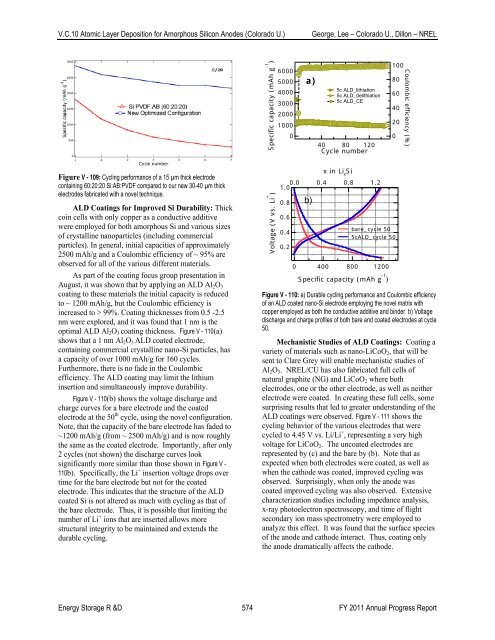V. Focused Fundamental Research - EERE - U.S. Department of ...
V. Focused Fundamental Research - EERE - U.S. Department of ...
V. Focused Fundamental Research - EERE - U.S. Department of ...
You also want an ePaper? Increase the reach of your titles
YUMPU automatically turns print PDFs into web optimized ePapers that Google loves.
V.C.10 Atomic Layer Deposition for Amorphous Silicon Anodes (Colorado U.)<br />
George, Lee – Colorado U., Dillon – NREL<br />
Figure V - 109: Cycling performance <strong>of</strong> a 15 µm thick electrode<br />
containing 60:20:20 Si:AB:PVDF compared to our new 30-40 µm thick<br />
electrodes fabricated with a novel technique.<br />
ALD Coatings for Improved Si Durability: Thick<br />
coin cells with only copper as a conductive additive<br />
were employed for both amorphous Si and various sizes<br />
<strong>of</strong> crystalline nanoparticles (including commercial<br />
particles). In general, initial capacities <strong>of</strong> approximately<br />
2500 mAh/g and a Coulombic efficiency <strong>of</strong> ~ 95% are<br />
observed for all <strong>of</strong> the various different materials.<br />
As part <strong>of</strong> the coating focus group presentation in<br />
August, it was shown that by applying an ALD Al 2 O 3<br />
coating to these materials the initial capacity is reduced<br />
to ~ 1200 mAh/g, but the Coulombic efficiency is<br />
increased to > 99%. Coating thicknesses from 0.5 -2.5<br />
nm were explored, and it was found that 1 nm is the<br />
optimal ALD Al 2 O 3 coating thickness. Figure V - 110(a)<br />
shows that a 1 nm Al 2 O 3 ALD coated electrode,<br />
containing commercial crystalline nano-Si particles, has<br />
a capacity <strong>of</strong> over 1000 mAh/g for 160 cycles.<br />
Furthermore, there is no fade in the Coulombic<br />
efficiency. The ALD coating may limit the lithium<br />
insertion and simultaneously improve durability.<br />
Figure V - 110(b) shows the voltage discharge and<br />
charge curves for a bare electrode and the coated<br />
electrode at the 50 th cycle, using the novel configuration.<br />
Note, that the capacity <strong>of</strong> the bare electrode has faded to<br />
~1200 mAh/g (from ~ 2500 mAh/g) and is now roughly<br />
the same as the coated electrode. Importantly, after only<br />
2 cycles (not shown) the discharge curves look<br />
significantly more similar than those shown in Figure V -<br />
110b). Specifically, the Li + insertion voltage drops over<br />
time for the bare electrode but not for the coated<br />
electrode. This indicates that the structure <strong>of</strong> the ALD<br />
coated Si is not altered as much with cycling as that <strong>of</strong><br />
the bare electrode. Thus, it is possible that limiting the<br />
number <strong>of</strong> Li + ions that are inserted allows more<br />
structural integrity to be maintained and extends the<br />
durable cycling.<br />
-1<br />
Voltage (V vs. Li + ) Specific capacity (mAh g )<br />
100<br />
6000<br />
5000 a) 80<br />
5c ALD_lithiation<br />
4000<br />
5c ALD_delithiation 60<br />
5c ALD_CE<br />
3000<br />
40<br />
2000<br />
1000<br />
20<br />
0 0<br />
40 80 120<br />
Cycle number<br />
x in Li x<br />
Si<br />
0.0 0.4 0.8 1.2<br />
1.0<br />
0.8<br />
0.6<br />
0.4<br />
0.2<br />
b)<br />
bare_cycle 50<br />
5cALD_cycle 50<br />
0 400 800 1200<br />
Specific capacity (mAh g -1 )<br />
Figure V - 110: a) Durable cycling performance and Coulombic efficiency<br />
<strong>of</strong> an ALD coated nano-Si electrode employing the novel matrix with<br />
copper employed as both the conductive additive and binder. b) Voltage<br />
discharge and charge pr<strong>of</strong>iles <strong>of</strong> both bare and coated electrodes at cycle<br />
50.<br />
Mechanistic Studies <strong>of</strong> ALD Coatings: Coating a<br />
variety <strong>of</strong> materials such as nano-LiCoO 2 , that will be<br />
sent to Clare Grey will enable mechanistic studies <strong>of</strong><br />
Al 2 O 3 . NREL/CU has also fabricated full cells <strong>of</strong><br />
natural graphite (NG) and LiCoO 2 where both<br />
electrodes, one or the other electrode, as well as neither<br />
electrode were coated. In creating these full cells, some<br />
surprising results that led to greater understanding <strong>of</strong> the<br />
ALD coatings were observed. Figure V - 111 shows the<br />
cycling behavior <strong>of</strong> the various electrodes that were<br />
cycled to 4.45 V vs. Li/Li + , representing a very high<br />
voltage for LiCoO 2 . The uncoated electrodes are<br />
represented by (c) and the bare by (b). Note that as<br />
expected when both electrodes were coated, as well as<br />
when the cathode was coated, improved cycling was<br />
observed. Surprisingly, when only the anode was<br />
coated improved cycling was also observed. Extensive<br />
characterization studies including impedance analysis,<br />
x-ray photoelectron spectroscopy, and time <strong>of</strong> flight<br />
secondary ion mass spectrometry were employed to<br />
analyze this effect. It was found that the surface species<br />
<strong>of</strong> the anode and cathode interact. Thus, coating only<br />
the anode dramatically affects the cathode.<br />
Coulombic efficiency (%)<br />
Energy Storage R &D 574 FY 2011 Annual Progress Report



